The Tibetans in-exile seem to be heading towards obsolescence. For some time now, there has been an Indian law in place making it legal for those of Tibetan descent born between January 1950 and July 1987, to hold Indian passports which by default makes them Indian citizens. That law has recently been tested in the Indian courts and has become precedent. Many Tibetans are flocking to become Indian nationals and to enjoy the rights of a free and democratic country.
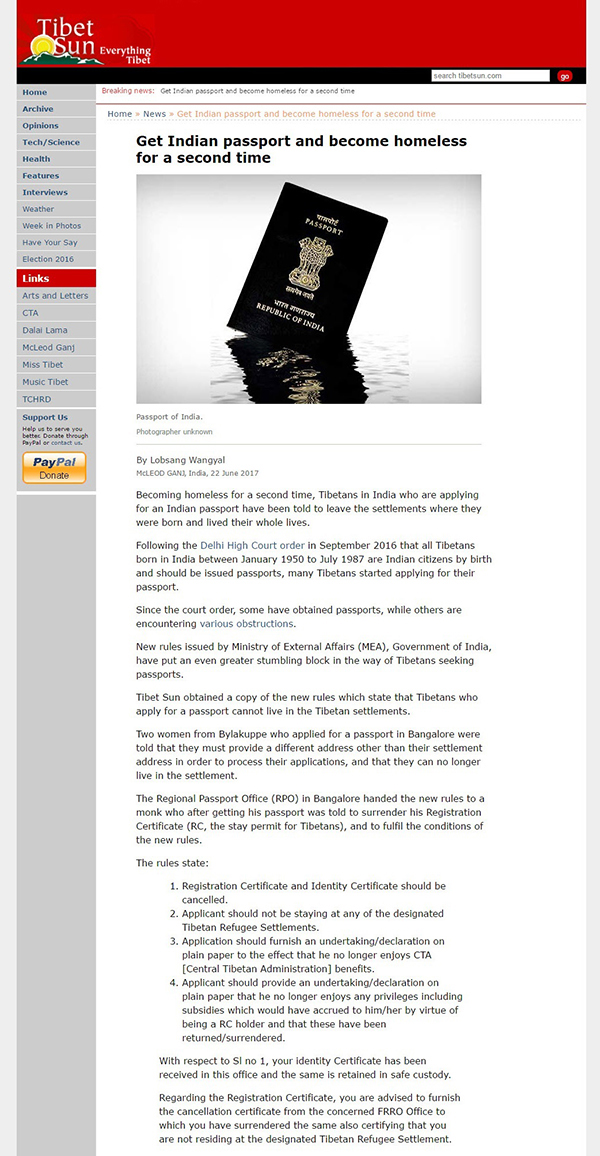
Click to read the full report
In 1959, India graciously accepted the influx of Tibetan refugees and granted them a 99-year lease on 24 tracts of land throughout India on the condition that they remain there as refugees. As refugees without any legal rights, the Indian government sought to ease the difficult conditions faced by the refugees by granting them protectorate status as well, allowing them to travel outside of their 24 Tibetan settlements (this number could have changed by now) and internationally.
However, in order for a Tibetan to enter or leave these settlements, they must register their movements at local police stations and Tibetan refugees travelling within India and abroad must first have the relevant travelling papers, or Identity Card (‘yellow book’) issued by the Indian government. This in turn is on the condition that they have a proper registration certificate issued by the Central Tibetan Administration (CTA) which they must renew, and this is where the challenge is, because the CTA is notorious for denying their own people the necessary documents if they are found not to toe the CTA line or simply because they have opinions that are different to those of the Tibetan leadership. The Tibetan Dorje Shugden followers have suffered greatly in this respect. All these unwritten and arbitrary rules make life very difficult for a people who are already handicapped by being stateless.
While the Tibetan people welcome the move by the Indian government to grant Indian passports and hence citizenship to those who qualify, they are strangely offended by the conditions imposed. In essence, once a Tibetan is granted an Indian passport he can no longer retain his Tibetan identity documents which comes with some entitlements such as being able to live in the Tibetan settlements. This has led some Tibetans such as Lobsang Wangyal of the Tibet Sun to voice their discontent. According to the stipulations being enforced by the Indian government, a Tibetan candidate for an Indian passport must, in effect, give up his or her rights as a Tibetan refugee (such as being able to live in the settlements, rights to subsidies, and foreign scholarships), a move which would in practice integrate them into Indian society with all the benefits thereof.
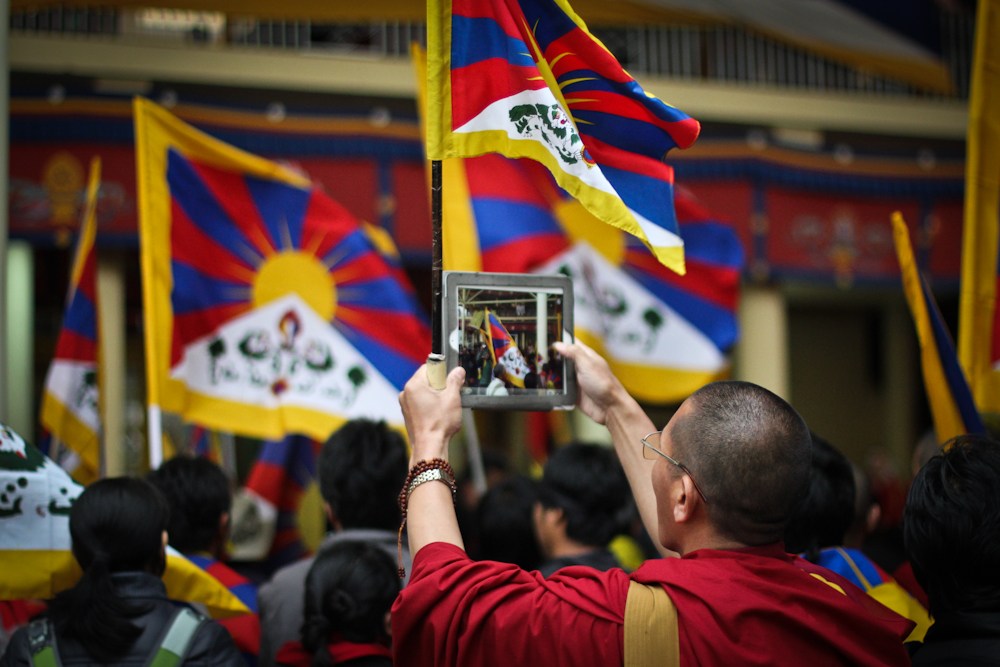
The move towards Indian citizenship hails more rights for Tibetans, not a loss of their culture
It is strange that the Tibetans should feel aggrieved by the Indian government’s conditions but why would the Indian government allow a Tibetan to be an Indian national and a Tibetan refugee at the same time? Which government in the world can allow that and how is that even possible?
This situation has raised a number of interesting points for all to consider:
Why Tibetans want Indian citizenship
To have Indian citizenship is attractive to Tibetan refugees as it would immediately remove a multitude of problems they are presently facing – ease of travel, qualification for gainful employment and common ground to engage with Indian society where they have lived in exile for decades.
- The wish to become lawful citizens. Currently, under the CTA, Tibetans are in stateless limbo, without a valid identity and with very limited entitlements, and no protection from the United Nations and other international bodies.
- The wish to travel freely. Tibetans are completely dependent on an archaic and indiscriminate CTA system for their travel papers which is difficult to obtain. And even after complying with strenuous conditions that proper citizens of nations enjoy casually, it is still troublesome for them to travel freely and some countries such Sweden even reject the validity of the Tibetan travel document.
- The wish to own property. Given their refugee status, Tibetans are not allowed to own property of any kind and hence do not enjoy security.
- The wish for financial security. Unlike Indian citizens, Tibetans are denied this opportunity to explore business and career opportunities in order to secure a future for themselves and their family.
- To mitigate lost hope. The Tibetans have given up on their leaders after decades of false hopes, broken promises and what is at best superficial efforts by the CTA to improve their quality of life. The CTA politicians on the other hand do not suffer the same fate as those who depend on them.
- Familiarity with India. After six decades, older generation Tibetans have acclimatized to the new life whilst the younger generations have no concept of life in Tibet. India is home to them.
- Fees to live abroad. Many Tibetans would like to emigrate abroad to places like Japan and the USA. But the extortionate fees charged by agents who arrange visas for Tibetans, who then claim political asylum as soon as they arrive at their destination, are beyond the means of an average Tibetan. Charged anywhere between Rs.800,000 – Rs.1,100,000 (roughly USD12,000- USD17,000), only Tibetans who have access to significant funding, like CTA officials, have any hope of making it to another country and once there, claiming political asylum that usually leads to full citizenship.
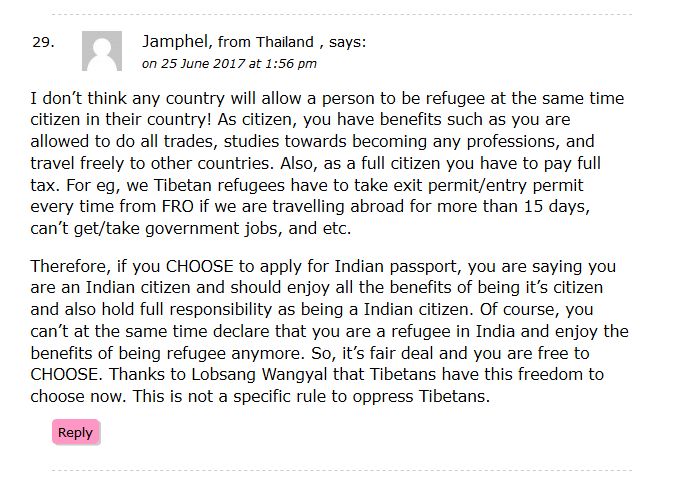
Comments left on the Tibet Sun article show that Tibetans endorse giving up Tibetan identity if they choose to become Indian citizens. Click to enlarge.
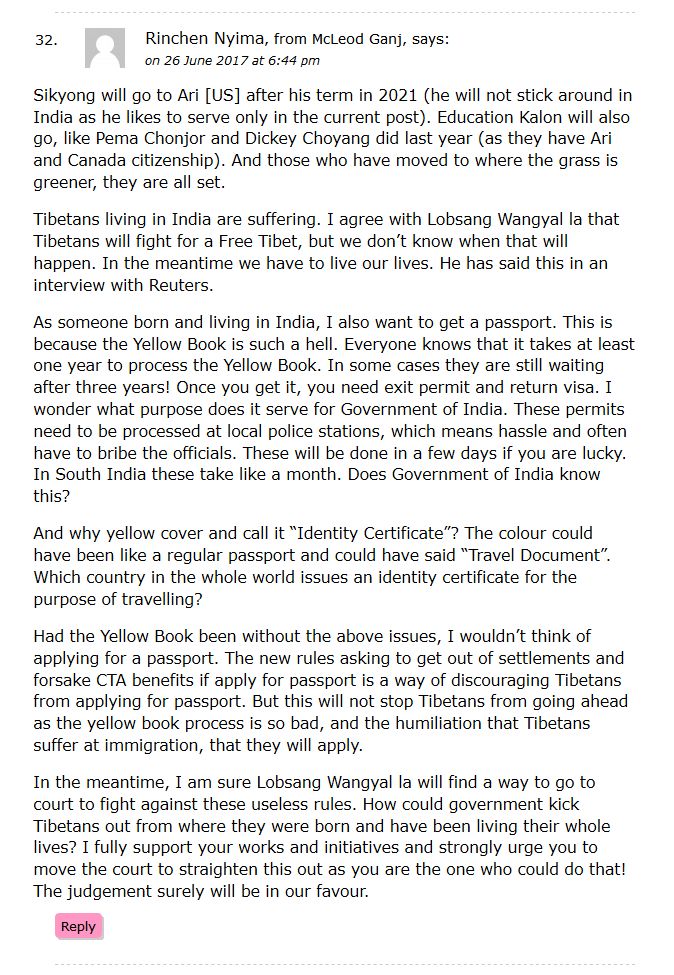
Even Tibetans in McLeod Ganj, the heart of Dharamsala, know the difficulties in getting an Identify Certificate, and would rather have an Indian passport. Click to enlarge.
Why Tibetans having Indian citizenship damages the CTA
Every single Tibetan deciding on Indian citizenship undermines the already shaky standing of the CTA. In the final analysis, the CTA has nothing to offer except well-worn pipe dreams.
- The CTA would have less influence. When a Tibetan becomes an Indian citizen, he is free of the binds of the CTA’s harmful and extremely oppressive policies. The CTA will lose control of the Tibetan people who will now be protected by Indian law and be entitled to all privileges available to citizens of India. And as the Tibetan person’s quality of life as an Indian national improves, he is less likely to pay any heed to the CTA’s old rhetoric.
- Reduced aid from abroad. The CTA has survived purely on handouts given by well-meaning countries and groups who are concerned about the welfare of the Tibetan people. Therefore if the Tibetan people are no longer stuck in a hapless situation, the need for these funds should correspondingly reduce and hence the justification for the CTA to ask for money diminishes. The CTA’s unquestioned, unaudited, unmarked gravy train would slow down and then stop altogether. It becomes much harder for the CTA to get money especially now when doubts about where the money has been going begin to emerge. The CTA leaders are well-known by the Tibetans to be highly corrupt.
- Accelerates the end of the ‘Tibetan Cause’. The CTA relies on the fact that the Tibetan people have no country to call home. If Tibetans take up citizenship in India, they now do have a country – India. They are no longer stateless, and fighting for their lost country of Tibet would not make sense, thus losing sympathy votes for aid, free money, and handouts. And the Tibetans on the whole are a master in putting on a good show for a handout. After all, what legitimate citizen of a nation, even if naturalized, can claim for help from other nations? Support yourself.
- CTA’s inadequacies become obvious – Opportunities and Education. Being an Indian citizen opens up many new opportunities for the erstwhile Tibetan refugee, and paves the way for a better life. This would highlight the CTA’s negligence and incapacities, and overall disinterest in helping their community.
- Loss of identity. Becoming Indian citizens would mean the first step of Tibetans assimilating into Indian culture, much like Tibetans who migrated to Nepal centuries ago and are no longer distinguishable from the local Nepalese culture. With the loss of Tibetan identity, there is also less of a reason to fight for Tibet. This is not a unique experience; any refugee who is naturalized becomes a part of that nation in spirit, guarding the laws, and becoming a integrated member of that country’s society. So their loyalties for the nation they have left would fade away in time as new generations emerge and are born directly into those foreign countries. Therefore, Tibet does become a part of China, not only legally but by virtue of the fact that Tibetans naturalized as citizens elsewhere are less concerned about their country of origin.

It is clear that people believe India to be of more benefit than the CTA. India has done more for the Tibetans than their own government. Click to enlarge.
CTA’s failure towards Tibetans
Given so much Tibetan interest in Indian citizenship, it has to be asked – what made the CTA such a failure that their own people are now looking to become citizens of other countries?
- The CTA have accomplished nothing for their people. Despite staged portrayals, the CTA have not done much for its people. The asylum, land and new life that the refugees currently enjoy were bestowed upon them by a benevolent India. The CTA has done very little to improve the people’s livelihood and future. As proof we see how many Tibetans who went into voluntary exile to follow the Tibetan leadership have since emigrated to other countries. Many even decided to return to the Tibet Autonomous Rule under China which is a slap to the CTA. Those who continue to trust the CTA remain poor and dependant. Contrary to prevalent beliefs, the influx of Tibetans seeking refuge in India has significantly lessened. On the whole, Tibetans no longer want to leave Tibet to live in India under the CTA.
- No sign of going home. While the CTA have always maintained that their aim is to regain Tibet, over 60 years have passed and there is no sign that this is even possible, or that they are on the right track. Generations of Tibetan lives have been sacrificed. The CTA and many of the exiled Tibetans, although enjoying many benefits in India are still not self-reliant and asking for handouts, which contradicts Tibetans who migrate out of India, who do not ask for handouts. This is clear proof that the CTA has failed, as Tibetan immigrants in other countries do not rely on handouts because they are not under the jurisdiction nor rely on the CTA. Tibetans in the UK, Canada and Japan for example do not ask any government, let alone the Trump administration, for financial help.
- Failed approaches. Whether it is rangzen (full independence) or umaylam (meaningful autonomy) the Tibetan cause remains academic as there is no evidence to indicate that the CTA can successfully draw the Chinese government to negotiate because the CTA’s methods continue to be ineffective. Neither have the Tibetan leaders been able to enrol Indian politicians to truly support their campaigns. The CTA fail to realize they should stop courting Western governments and start befriending China. Since the international community accept that Tibet is a part of China, the Tibetan people’s salvation lies in the hands of China itself.
- Leased land. The Tibetans are running out of time as India did not give the land to the Tibetans but merely leased it for 99 years. More than half of that lease has been exhausted but still, 30 years remain. In offering Indian citizenship to the Tibetan people with 30 years left on the lease, the Indian government signals its disbelief that the Tibetans will ever regain their country, despite having another three decades available to them. Perhaps, the wise Indian government is preparing the refugee Tibetans for the eventual demise of the Dalai Lama who is the magnet that draws the money from abroad for the CTA to sponge off of. Everyone knows that the financial drawing power for the Tibetan refugees in India is the Dalai Lama, and he is 83 years of age.

Over the last 60 years the CTA have not even secured land for Tibetans after the 99 year lease from India is over. Click to enlarge.
Why staying as refugees does not help the Tibetans
In trusting the CTA, the Tibetan people find themselves having to ask an honest question – what benefit is there to remain Tibetan refugees?
- Being refugees means they continue to depend on an illegitimate ‘government’, and to continue to live without democratic rights, and to not be entitled to United Nation protection, to not have real opportunities and also to have a bleak and unsure future given the way the CTA loses global friends and supporters at an alarming rate. The only reason anyone gives consideration or financial aid to the Tibetans is because of the Dalai Lama, and the Dalai Lama will not live forever.
- Restricted travel. As China’s influence grows, anything related to CTA becomes taboo and more and more countries will close its doors to Tibetans in exile. Those with a Yellow Book will find it increasingly difficult to enter any country, and the Yellow Book will eventually no longer be considered a legitimate travel document when traveling abroad. It has already been banned in Sweden.
- False sense of entitlement. Under the CTA’s poor leadership, some Tibetans have developed the mind-set that they are entitled to handouts rather than have to earn it like everyone else in the world. You see this in the comments made by Tibetans criticizing the Indian government’s policies. This mentality does not augur well for the Tibetan people in a highly competitive and skilled world.
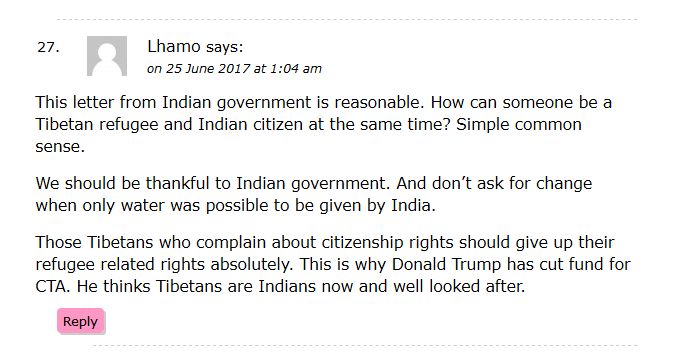
Tibetans consider it reasonable to give up their Tibetan rights to become Indian citizens. It begs the question, if their government was not mismanaging their people, wouldn’t Tibetans rather prefer to stay under the CTA? Click to enlarge.
The suggestion that becoming an Indian citizen means selling out
There is a prevailing sentiment in the Tibetan community that to no longer depend on the CTA and be willing to suffer unnecessarily as a refugee, is to betray the Tibetan cause. But the same standard is not applied to CTA politicians and Tibetan leaders.
- Returning to Tibet. If a Tibetan decides to become a naturalized Indian citizen, he is instantly seen as no longer wishing to return to Tibet and hence a traitor who has betrayed the cause. Why is it that in order to safeguard a better life, essentially doing something that the CTA is supposed to be doing but failed, the ordinary Tibetan must be subjected to such abuse? This is how the CTA psychologically controls and abuses its own people.
- Stigma. Either way, under the leadership of the CTA, the Tibetan refugee is stigmatized – as a freeloading refugee who refuses to help himself if he does not seek Indian citizenship, or alternatively a traitor if he decides to help himself and become an Indian citizen. The choice however is clear since being a refugee bears legal, regulatory and diplomatic implications whereas being a ‘traitor’ is merely a matter of opinion.
- Loss of trust – A fact. Regardless of opinion, the fact that Tibetans are even considering Indian citizenship, even going to court for it, means there is significant loss of faith in the CTA. The threat of being labelled a ‘traitor’ is not even a significant factor as Tibetans are well aware that most CTA officials hold Indian passports and that of other countries. Oddly, instead of directing their frustration at their own hypocritical leaders, Tibetans vent their irritation at the Indian government who are already at considerable disadvantage by hosting the Tibetan refugees for decades, to the ire of China, a powerful neighbour and necessary trade partner. Supporting the Tibetan refugees has proven to be a losing proposition for India.
- Betraying His Holiness the Dalai Lama. As much as being a refugee is to deny oneself a range of rights and opportunities, some Tibetans are made to feel that taking Indian citizenship is a direct insult to the Dalai Lama. This in essence is to inflict spiritual suicide for a people who are staunchly religious and superstitious. In addition, if most of the refugees in India are becoming Indian citizens and or citizens of other countries, will the Dalai Lama continue with his Yellow Book or become a naturalized Indian citizen? After all, the Dalai Lama himself is a supposed refugee, but by the looks of how the CTA lives, there is not any semblance of being a genuine refugee.

Strongly-worded reply aimed at Tibetans who have emigrated abroad commenting about what Tibetans living in India should do. Click to enlarge.
Why it is wrong for Tibetans to vent their frustrations at India
The Tibet Sun article and many of the comments therein are directed at the Indian authorities in a negative way. Would it not make more sense to discuss matters with the government in a friendly and polite manner, rather than threaten legal action or make demands? After all, the Indian government has gone beyond the call of duty for the refugees for 60 years, and the Tibetans are still complaining. Ungrateful is an understatement. India provided safe asylum for Tibetan mothers, fathers and families after they fled Tibet. They basically allowed the Tibetans to live on their lands for free, out of the kindness of their hearts, without any preconditions or expectations, for example for taxes to be paid. Making demands of the Indian government does not benefit the Tibetans, especially since as subjects of the CTA, they enjoy no rights within the Indian political system. It also shows why many observers believe that sooner or later, the CTA and Tibetans in exile will lose India’s support.
Nothing in the Indian conditions for passport raises red flags. However, there are some potential reasons why the Indian government may make it difficult for the Tibetans to naturalize easily.
- Risk of upsetting China. The Chinese consider Tibetans to be a part of Tibet, therefore giving Indian citizenship may be viewed as an assault on the sovereignty of their people. The Tibetans have become the bane of political stability within the region.
- Since the CTA exists, Tibetans do not really need or want citizenship. The existence of the CTA and the Tibetan people’s support for their “government” in exile can be taken to mean that the Tibetans already regard themselves as citizens of a defunct Tibetan nation regardless of the fact that the CTA is a government with no country.
- An insult to India. It is well-known that Tibetans travel to other countries and naturalize there. This could be seen as an insult, that they do not see India as a worthy country to which they would want to belong. India has granted them so much over the last 60 years, asking nothing in return, yet Tibetans repay this kindness by emigrating to other countries, or complaining that the Indian government is unfair in its stipulations for citizenship, as stated in the article. In fact, the stipulations to become naturalized are simple and fair. The Tibetans again want the easy way out, a free hand – citizenship with no conditions.
- To ensure Tibetans really want to become Indian. A harder process may be India’s way of gauging the Tibetan applicant’s commitment to become a citizen. After all, a citizen cannot be loyal to two separate countries.
- To force Tibetans to return to China. India may not even really want an influx of Tibetans as Indian citizens. After all, the Tibetans have contributed little to India in almost 60 years and to do more for the Tibetan people could strain Sino-Indian relations. Instead, India may be giving the Tibetan people reasons to return to Tibet as many have recently.
- Souring diplomatic relations. The CTA have failed to successfully advance diplomatic relations with India since the time of Prime Minster Nehru, giving little reasons for India to go out on more of a limb for the Tibetan people. In fact, the Tibetans create more tensions to prevent Sino-Indian relations from normalizing. Tibetans in exile are in fact happy when Sino-Indian relations are strained because they see it as a benefit to themselves. They never consider the benefits of their kind host country of India. If Sino-Indian relations normalize and become friendly, it would benefit over 1 billion Indians, as well as stabilize Asia, for China and India are the two massive Asian giants. Their peaceful co-existence is crucial for stability in Asia. Tibetans only think of themselves.
- Growing tensions are rising. The Indian government is aware of rising negative sentiments against the Tibetan refugee populace who gain so much (e.g. not having to pay taxes) and yet give so little in return. The Lal Qilla fire at the Tibetan sweater market is evidence of this tension. Naturalized Tibetans may be perceived to take Indian jobs and adding to job market competition, leading to even more tension.
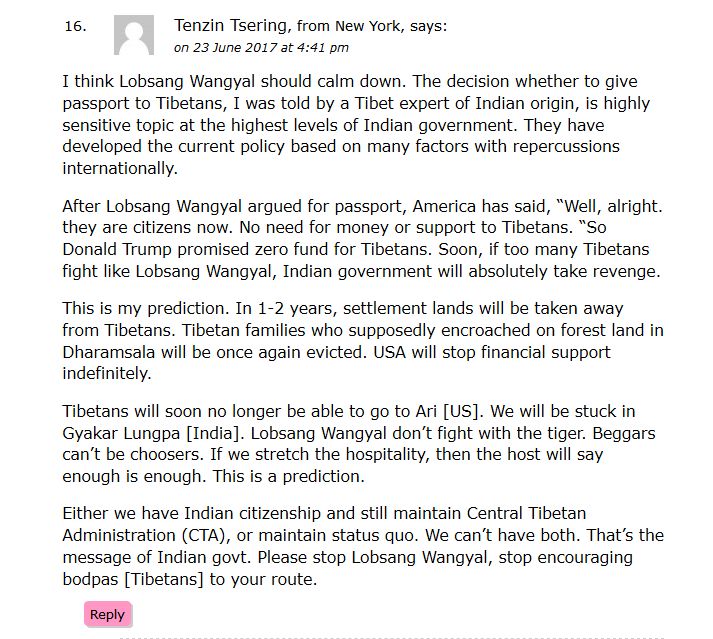
Many Tibetans are aware that the hospitality of India can run out. Why make enemies with them? Click to enlarge.
Why the Tibetan leadership remains silent
Where is the CTA in all this debacle? Rather than speaking up, telling their people to either remain under the CTA, or even helping them through their difficulties with the Indian government, the Tibetan leadership have not uttered a single word about the issue.
There might be a number of reasons for this:
- Do not want to upset Indian government. There is a possibility that the CTA wishes to avoid being seen as demanding as they have taken so much for 60 years and given nothing in return.
- Avoid exposure. It is a well-known fact among Tibetans in exile that their top leaders such as Sikyong (President) Lobsang Sangay and Dhardon Sharling (Secretary of the Department of Information and International Relations) hold foreign passports and citizenships despite this being forbidden by Indian law. Even other figures such as Pema Chonjor and Dickey Choyang, have American and Canadian citizenships, as well as Yellow Books. And therefore the same leaders are leaving it to the ordinary Tibetan to sort out the problem to avoid being questioned about this gross double standard. This double standard itself indicates a serious problem within the Tibetan political setup – gross inequality that raises the question of how genuinely the Tibetan leaders are representing the Tibetan people.
- Silence because of hypocrisy. Since it is known they do not follow their own policies and operate with double standards, the CTA do not want to highlight the fact otherwise they would look even worse. It is odd that the CTA should be so aggressive and vocal when it comes to discriminating against a religious practice such as Dorje Shugden and yet remain cowardly meek when it comes to such important issues that affects the future of the Tibetan people.
- They do not know what to do. Perhaps the most worrying of all, is that the CTA may not be doing anything about the situation because they simply do not know what to do in the situation. If this is the case, it is better the Tibetans brave the difficulties in gaining Indian citizenship. How can anyone rely on such a weak and impotent government? We saw the same ineptitude and lethargy in the way the CTA failed to curb the spate of self-immolations.
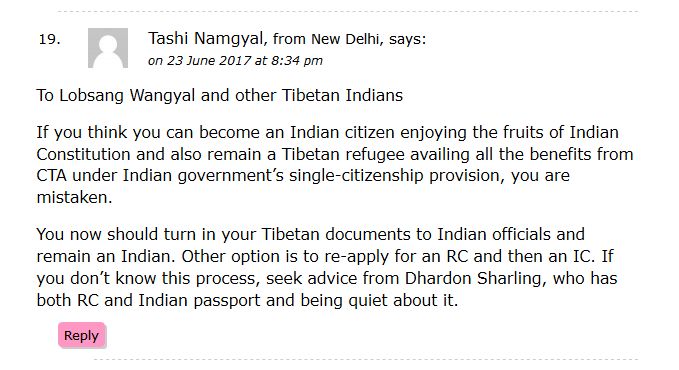
It is a well-known fact that the CTA’s top leaders, such as Sikyong Lobsang Sangay and Dhardon Sharling have foreign passports as well CTA identity documents. Click to enlarge.
Who is right?
While some commentators say that the Indian authorities are being unfair, we have to look objectively at the conditions they imposed on Tibetans applying for Indian passports.
- Logical. An objective examination of the conditions imposed on Tibetans applying for Indian passports concludes that the stipulations are in fact quite reasonable. After all, how can someone claim to be a stateless Tibetan refugee AND a citizen of India at the same time? As a matter of fact, the existence of the CTA who classes itself as the de facto government on a land that has its own elected and legitimate government itself is illogical. Two separate and distinct governments cannot exist on the same land. If all Tibetans become naturalized Indian citizens, how can they continue to work for or support the CTA as a de facto government in exile? Whose rulings and policies would take precedence, the Indian government or the Tibetan leadership’s? The CTA has it own Prime Minister or President, which is Sikyong Lobsang Sangay, which shows it is its own political body. How can there be two Prime Ministers in one country?
- Fair demands. Since India has already gone out on a limb to provide, at great cost, for Tibetans for 60 years, it is wrong and unfair to think of India’s conditions which are required by law, to be onerous and unreasonable. As it is the Indian government has granted the Tibetan people protection under an asylum, land on which Tibetan settlements stand, and tolerated the Tibetan leadership for decades. But instead of being grateful to India for this privilege, the Tibetan leadership and their supporters choose to complain about the conditions that India imposes upon them. Have they forgotten that the only reason the leadership even has a place to station themselves is due to the kindness of the Indian leadership? The very fact the Dalai Lama is allowed to do as he pleases and the Tibetans are always campaigning for a free Tibet on Indian soil, which is itself a strain on Sino-Indian relations, shows the broad latitude the Tibetans have been given. Yet they are not satisfied and demand more. The Tibetans need to realize that having an Indian passport is a privilege, not an entitlement.
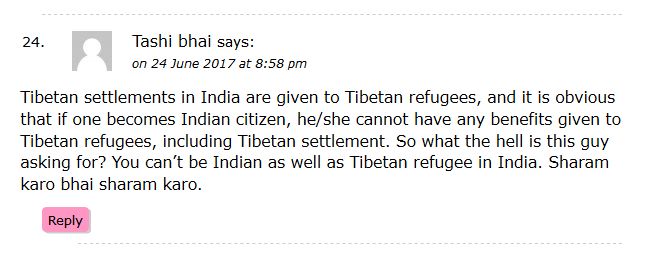
It is logical that Tibetans give up the benefits of being considered a refugee if they become Indian citizens. Here a Tibetan asks the author of the article to “have shame brother, have shame” (translation from Hindi) about his comments that India is making Tibetans give up their Tibetan identity. Click to enlarge.
The end of the CTA
It does not take much to see that the entire basis of the CTA’s existence is flawed, the reasoning of the Tibetans fraught with self-serving considerations and the behaviour of the Tibetan leadership anarchical and absurd. In a world where information flows freely and the world is becoming globalized, how far can the CTA go with the way they have been conducting themselves and supposedly ‘governing’ their own people? Just like their many abusive policies such as their persecution of a large community of their own people based on religion, the CTA’s policies are increasingly being exposed to be juvenile, delinquent and downright unlawful. Just by looking at this Indian passport saga reveals a lot about the CTA and the bizarre culture they have engendered.
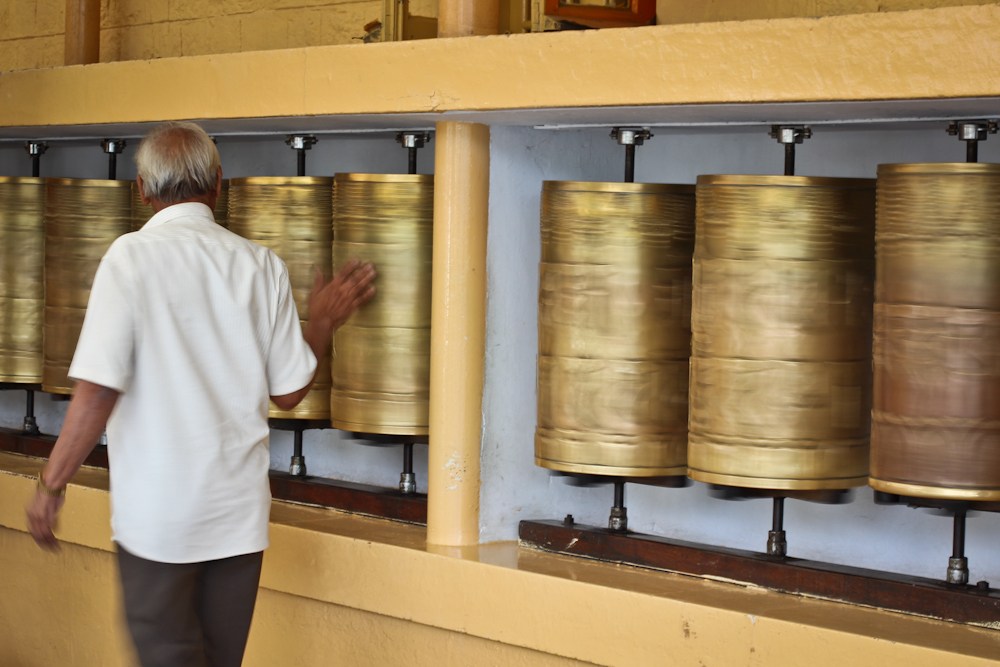
Indian citizenship secures the future of Tibetans and their descendants. The CTA does not.
The fact that many people are beginning the process of becoming Indian citizens, does not speak well for the CTA who have had ample time to improve their people’s situation, and neither does it bode well for their future. In fact it shows the CTA’s outright and abysmal failure as an administration of a small group of refugees. They have not improved the lives of its people, and neither have they regained their country, either through independence, meaningful autonomy, or friendly relations with China. In essence it is because of the CTA’s inability that ordinary Tibetans are now forced to get citizenship from India. This was not something they would have done decades ago, but as the CTA continue with their mismanagement, corruption and bad politics, the Tibetans themselves are forced to act on their own.
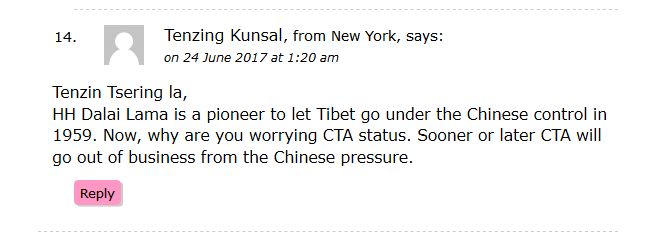
A prediction of the end of the CTA by a Tibetan from New York, USA. Click to enlarge.
Overall, the CTA are not grateful towards India, even though they have some rights under the guise of being a refugee. If you look at the standard of living of many Tibetans in their settlements, it is much higher than their Indian counterparts. Many of the “refugees” in the Tibetan settlements in India actually own very beautiful cars, mansions, carry two passports (illegally), and yet they remain unhappy as well as ungrateful towards India.
Why do you never hear about Tibetans speaking up for Indian causes or Indian orphans? Why do you not hear of the CTA creating orphanages, soup kitchens, battered women’s shelters, rehabilitation facilities for local Indians, millions of whom live well below the poverty line? Why do the Tibetan guests not master Indian culture or learn to read and write Indian languages fluently? Why do they not master Indian dance, art, or music? Why is it that the so-called “refugees” never sell textiles produced by single mothers in India, who sincerely need help to survive? Likewise, Tibetans do not open up hospitals or clinics to treat the local Indian populace, or care for the elderly and dying, like Mother Theresa did in Calcutta. Someone like Mother Theresa was granted the honor of Indian citizenship for her 50 years of service, during which she relieved the plight of the poor, sick and homeless in India, and she asked for nothing in return. She was a foreigner as well.
The majority of Tibetans in India and their so-called CTA “leaders” never address issues such as how to relieve the social ills plaguing India, her poverty, or discuss how Tibetans can contribute to Indian society. Yet they quibble, argue and sue their host country’s government for a passport that they are really not entitled to. It is an honor, a blessing and privilege to carry an Indian passport, graciously bestowed on a Tibetan refugee, and yet in their ingratitude all they think about is migrating to another county. Tibetans deserve human dignity and opportunities like everyone else, but they should stop whining over their supposed difficulties as refugees in India, and forcing the privilege of having citizenship.
No country in the world has been as generous and kind to the Tibetan diaspora as Mother India has. Yet they receive nothing in return. Perhaps the Dalai Lama and his “democratically” appointed secular and spiritual leaders should teach their community the physical and tangible ways to repay the biggest kindness they have received since 1959, during the most darkest of moments in Tibetan history.
The CTA’s own machinations have landed them in their own snares. As the CTA’s significance wanes, the Tibetan people will eventually no longer feel the need to listen to anything the CTA says, but will instead be obliged to follow democratic Indian law, as does every other Indian citizen.
Get Indian passport and become homeless for a second time
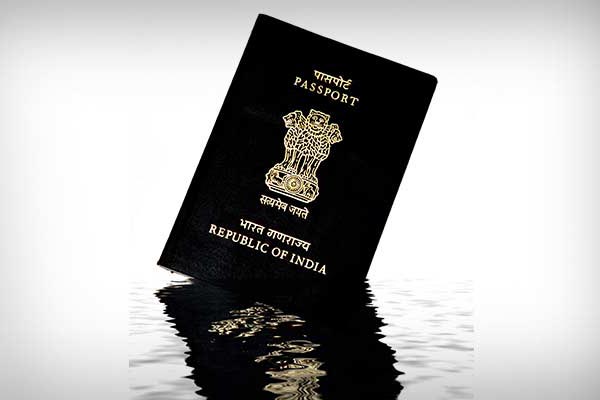
Passport of India
Becoming homeless for a second time, Tibetans in India who are applying for an Indian passport have been told to leave the settlements where they were born and lived their whole lives.
Following the Delhi High Court order in September 2016 that all Tibetans born in India between January 1950 to July 1987 are Indian citizens by birth and should be issued passports, many Tibetans started applying for their passport.
Since the court order, some have obtained passports, while others are encountering various obstructions.
New rules issued by Ministry of External Affairs (MEA), Government of India, have put an even greater stumbling block in the way of Tibetans seeking passports.
Tibet Sun obtained a copy of the new rules which state that Tibetans who apply for a passport cannot live in the Tibetan settlements.
Two women from Bylakuppe who applied for a passport in Bangalore were told that they must provide a different address other than their settlement address in order to process their applications, and that they can no longer live in the settlement.
The Regional Passport Office (RPO) in Bangalore handed the new rules to a monk who after getting his passport was told to surrender his Registration Certificate (RC, the stay permit for Tibetans), and to fulfil the conditions of the new rules.
The rules state:
- Registration Certificate and Identity Certificate should be cancelled.
- Applicant should not be staying at any of the designated Tibetan Refugee Settlements.
- Application should furnish an undertaking/declaration on plain paper to the effect that he no longer enjoys CTA [Central Tibetan Administration] benefits.
- Applicant should provide an undertaking/declaration on plain paper that he no longer enjoys any privileges including subsidies which would have accrued to him/her by virtue of being a RC holder and that these have been returned/surrendered.
With respect to Sl no 1, your identity Certificate has been received in this office and the same is retained in safe custody.
Regarding the Registration Certificate, you are advised to furnish the cancellation certificate from the concerned FRRO Office to which you have surrendered the same also certifying that you are not residing at the designated Tibetan Refugee Settlement.
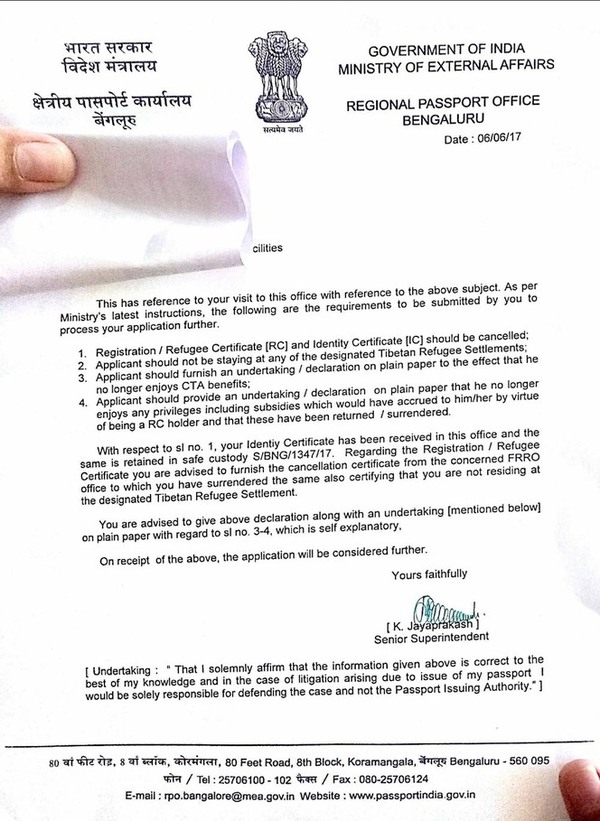
Click to read the letter
The monk from Bangalore signed an undertaking to this effect when he surrendered his RC.
Tsering, a Tibetan resident of Forsyth Ganj near McLeod Ganj, whose application is pending due to a permanent address issue, said that he was asked to sign an undertaking at Shimla RPO stating that he will not take benefits of CTA.
The rules have put Tibetans in a dilemma as they want the benefits of a passport, but applying for one would make them homeless.
Further, the rules are confusing in saying that an applicant can no longer enjoy CTA benefits. CTA is an independent entity, run by exile Tibetans with the main aims of working for a free Tibet and looking after the welfare of Tibetans.
The question arises whether Tibetans after getting Indian passport are no longer a part of the CTA, and cannot get benefits such as the Fulbright scholarships sponsored the US government.
Not every benefit and opportunity managed by CTA is dependent on holding an RC. What about the fact that many top leaders in the CTA do not possess RC — including the Sikyong (President of CTA)?
Advocate Simarpal Sawhney in Delhi in an interview told Tibet Sun that these new MEA rules for Tibetans are in violation of Article 14 and Article 21 of the Constitution of India.
“These rules are made by some officials, not following any existing law. There is every reason to challenge these rules in court,” Sawhney said.
Meanwhile, due to lack of clear information at various RPOs about the court order to issue passport to Tibetans and the procedure to process applications, many Tibetans are left in limbo.
A Tibetan monk from Mainpat told Tibet Sun that the RPO Raipur, the capital of Indian state Chattisgarh, refused to accept his application.
“I was told by the officials of RPO Raipur that Tibetans will not be issued passports,” the monk said.
There has been no reply to an email enquiry about the issue, and all calls to the RPO have gone unanswered.
The RPO denying passports to Tibetans is seen as defying the Delhi High Court order of 22 September 2016, as well as the MEA letter of 17 March 2017, ordering RPOs to issue passport to eligible Tibetans (born between 1950 and 1987, and their children).
Many Tibetans under the jurisdiction of Kangra Suprintendant of Police receive an adverse police verification report, stating they don’t own land and property, and hence their permanent address cannot be approved.
They are then stuck not knowing what to do, wondering if possessing land or property is a condition to get a passport, which it is not.
Due to lack of clear rules about processing and surrendering RC and IC (the Yellow Book issued to Tibetans for travel purposes in place of a passport), Tibet Sun filed a RTI (Right to Information) request with the following questions:
- What is the procedure to surrender IC (the Yellow Book) when people of Tibetan parentage apply for a new Indian passport following the Delhi High Court order?
- If there is a rule regarding surrender of IC, have all the RPOs been instructed to follow the rule?
- Should the RPOs return the IC to the holder, as the book has the person’s travel record?
- Should the RPOs mention the IC number in the ‘Old Passport number’ field at the back of the new Indian passport?
- Have there been any instructions to the FROs on how and when to surrender the Registration Certificate (RC)? Should the RC be surrendered at the nearest FRO like the IC is surrendered at the nearest RPO after getting the passport?
And the reply from the Consular, Passport and Visa (CPV) Division of the MEA, which is the authority responsible for issuing passports and ICs, was in part:
Point No.1:-
It may be noted that as per the provisions of Rule 13 of Passport Rules, 1980, a person at a certain point of time may not hold two valid travel documents and he has to surrender one of the two passports/valid travel documents to the Passport Authority.
Points No.2, 3 and 4:-
As such no information is available in this office (PV.I Section) of CPV Division of MEA. Hence, no information can be provided in this regard.
Point No.5:-
The information sought by the applicant does not pertain to this office and may be obtained from the Ministry of Home Affairs.
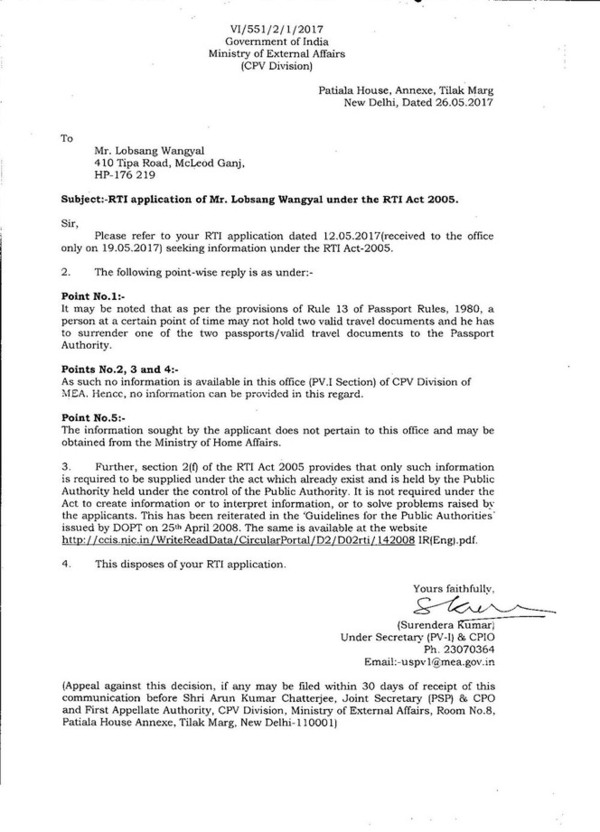
Click to read the letter
The RTI request was sent by post on 19 May, after the online RTI submittal form failed to work. A complaint to the Department of Personnel and Training, Government of India, about the failure of the online form went unanswered.

Click to read the full report
MORE NEWS LIKE THIS